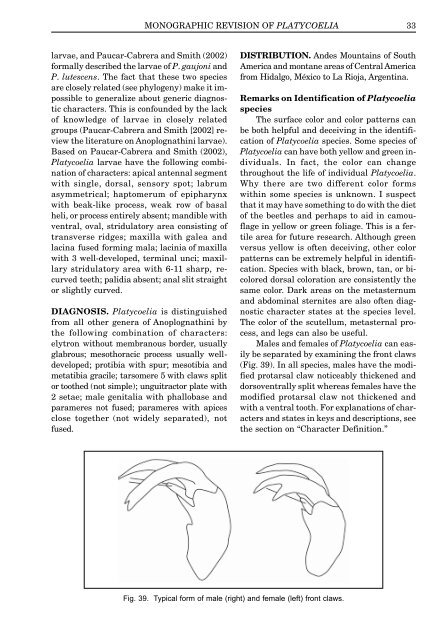Download full text (PDF 4.5 MB) - University of Nebraska State ...
Download full text (PDF 4.5 MB) - University of Nebraska State ...
Download full text (PDF 4.5 MB) - University of Nebraska State ...
Create successful ePaper yourself
Turn your PDF publications into a flip-book with our unique Google optimized e-Paper software.
larvae, and Paucar-Cabrera and Smith (2002)<br />
formally described the larvae <strong>of</strong> P. gaujoni and<br />
P. lutescens. The fact that these two species<br />
are closely related (see phylogeny) make it impossible<br />
to generalize about generic diagnostic<br />
characters. This is confounded by the lack<br />
<strong>of</strong> knowledge <strong>of</strong> larvae in closely related<br />
groups (Paucar-Cabrera and Smith [2002] review<br />
the literature on Anoplognathini larvae).<br />
Based on Paucar-Cabrera and Smith (2002),<br />
Platycoelia larvae have the following combination<br />
<strong>of</strong> characters: apical antennal segment<br />
with single, dorsal, sensory spot; labrum<br />
asymmetrical; haptomerum <strong>of</strong> epipharynx<br />
with beak-like process, weak row <strong>of</strong> basal<br />
heli, or process entirely absent; mandible with<br />
ventral, oval, stridulatory area consisting <strong>of</strong><br />
transverse ridges; maxilla with galea and<br />
lacina fused forming mala; lacinia <strong>of</strong> maxilla<br />
with 3 well-developed, terminal unci; maxillary<br />
stridulatory area with 6-11 sharp, recurved<br />
teeth; palidia absent; anal slit straight<br />
or slightly curved.<br />
DIAGNOSIS. Platycoelia is distinguished<br />
from all other genera <strong>of</strong> Anoplognathini by<br />
the following combination <strong>of</strong> characters:<br />
elytron without membranous border, usually<br />
glabrous; mesothoracic process usually welldeveloped;<br />
protibia with spur; mesotibia and<br />
metatibia gracile; tarsomere 5 with claws split<br />
or toothed (not simple); unguitractor plate with<br />
2 setae; male genitalia with phallobase and<br />
parameres not fused; parameres with apices<br />
close together (not widely separated), not<br />
fused.<br />
MONOGRAPHIC REVISION OF PLATYCOELIA 33<br />
DISTRIBUTION. Andes Mountains <strong>of</strong> South<br />
America and montane areas <strong>of</strong> Central America<br />
from Hidalgo, México to La Rioja, Argentina.<br />
Remarks on Identification <strong>of</strong> Platycoelia<br />
species<br />
The surface color and color patterns can<br />
be both helpful and deceiving in the identification<br />
<strong>of</strong> Platycoelia species. Some species <strong>of</strong><br />
Platycoelia can have both yellow and green individuals.<br />
In fact, the color can change<br />
throughout the life <strong>of</strong> individual Platycoelia.<br />
Why there are two different color forms<br />
within some species is unknown. I suspect<br />
that it may have something to do with the diet<br />
<strong>of</strong> the beetles and perhaps to aid in camouflage<br />
in yellow or green foliage. This is a fertile<br />
area for future research. Although green<br />
versus yellow is <strong>of</strong>ten deceiving, other color<br />
patterns can be extremely helpful in identification.<br />
Species with black, brown, tan, or bicolored<br />
dorsal coloration are consistently the<br />
same color. Dark areas on the metasternum<br />
and abdominal sternites are also <strong>of</strong>ten diagnostic<br />
character states at the species level.<br />
The color <strong>of</strong> the scutellum, metasternal process,<br />
and legs can also be useful.<br />
Males and females <strong>of</strong> Platycoelia can easily<br />
be separated by examining the front claws<br />
(Fig. 39). In all species, males have the modified<br />
protarsal claw noticeably thickened and<br />
dorsoventrally split whereas females have the<br />
modified protarsal claw not thickened and<br />
with a ventral tooth. For explanations <strong>of</strong> characters<br />
and states in keys and descriptions, see<br />
the section on “Character Definition.”<br />
Fig. 39. Typical form <strong>of</strong> male (right) and female (left) front claws.
















